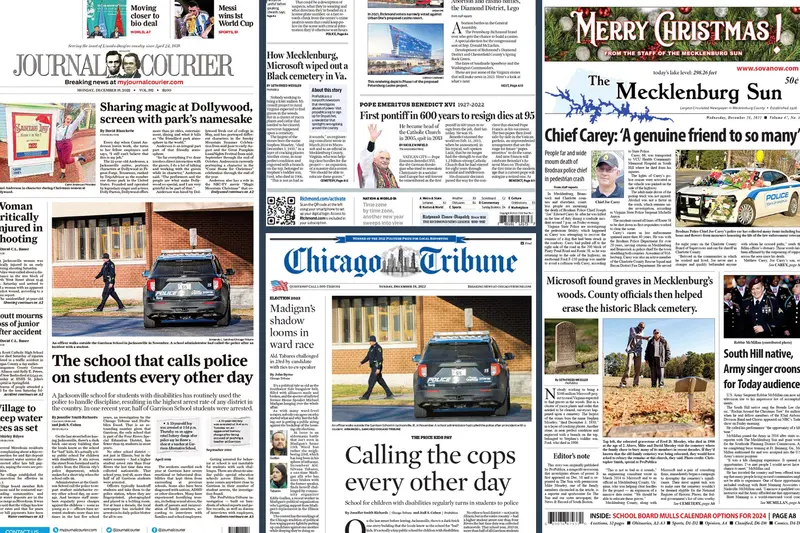News Articles Can Be Fun For Anyone
News Articles Can Be Fun For Anyone
Blog Article
News Articles Things To Know Before You Buy
Table of ContentsNews Articles - TruthsThings about News ArticlesNews Articles Can Be Fun For AnyoneThe Basic Principles Of News Articles What Does News Articles Mean?
Excellent understanding of different subjects provides students an affordable edge over their peers. Although electronic and social media are easily available, we must not fail to remember how crucial it is to read the newspapers. Moms and dads should attempt and inculcate the behavior of reviewing a paper as a day-to-day routine to proceed the heritage of the adored print tool.News tales also include at the very least one of the adhering to important qualities about the designated target market: proximity, prestige, timeliness, human rate of interest, quirk, or repercussion. The relevant term journalese is often made use of, typically pejoratively, to refer to news-style writing. Another is headlinese. Papers generally adhere to an expository writing style.
Within these limits, newspaper article also aim to be extensive. Various other variables are entailed, some stylistic and some acquired from the media kind. Among the larger and much more revered papers, fairness and balance is a significant variable in offering details. Commentary is normally restricted to a separate section, though each paper may have a different overall slant.
Newspapers with a global audience, for example, have a tendency to use an extra official design of writing. News Articles.; usual style overviews consist of the and the United States News Design Book.
How News Articles can Save You Time, Stress, and Money.
As a guideline, reporters will not use a long word when a short one will certainly do. They make use of subject-verb-object building and construction and vibrant, active prose (see Grammar). They use stories, examples and metaphors, and they seldom rely on generalizations or abstract concepts. News authors attempt to stay clear of using the same word greater than as soon as in a paragraph (sometimes called an "echo" or "word mirror").
Nonetheless, headings sometimes leave out the topic (e.g., "Leaps From Boat, Catches in Wheel") or verb (e.g., "Feline woman lucky"). A subhead (likewise subhed, sub-headline, subheading, subtitle, deck or dek) can be either a subservient title under the main headline, or the heading of a subsection of the article. It is a heading that precedes the major text, or a group of paragraphs of the major message.

of a short article subject, source, or interviewee), it is described as a drawn quote or pull quote. Added signboards of any of these kinds may show up later on in the write-up (specifically on subsequent web pages) to tempt more analysis. Journalistic websites often make use of computer animation strategies to swap one signboard for another (e.g.
A Biased View of News Articles
Such billboards are also used as pointers to the article in various other sections of the publication or site, or as advertisements for the piece in other magazine or websites. Press release of the Swiss government. Regular structure with title, lead paragraph (recap in vibrant), other paragraphs (details) and call information.

Example of a hard-lead paragraph NASA is recommending one more area task. The company's budget plan demand, announced today, consisted of a strategy to send another mission to the Moon. This time the firm hopes to establish a long-term facility as a jumping-off factor for various other space experiences. The spending plan requests approximately $10 billion for the project.
The NASA announcement came as the company requested $10 billion of appropriations for the project. An "off-lead" is the 2nd essential front web page information of the day. The off-lead shows up either in the top left corner, or straight below the check that lead on the right. To "hide the lead" is to begin the write-up with history information or information of additional importance to the readers, compeling them to learn more deeply right into an article than they need to have to in order to discover the crucial points.
How News Articles can Save You Time, Stress, and Money.
Usual use is that a person or 2 sentences each form their own paragraph. Journalists normally describe the company or structure of a newspaper article as an inverted pyramid. The necessary and most intriguing elements of a story are put at the beginning, with supporting details adhering to in order of decreasing significance.
It permits people to discover a subject to just the depth that their interest takes them, and without the imposition of information or subtleties that they might consider irrelevant, yet still making look at here that information available to a lot more interested viewers. The upside down pyramid framework additionally enables write-ups to be cut to any kind of approximate size throughout layout, to fit in the space available.
Some authors begin their stories with the "1-2-3 lead", yet there are many kinds of lead available. A kicker can refer to multiple points: The last tale in the news program; a "happy" tale to end the program.
Longer write-ups, such as magazine cover short articles and the items that lead the within sections of a paper, are called. Function stories vary from straight information in several means. Foremost is the lack of a straight-news lead, many of the time. Rather of using the essence of a tale in advance, feature authors may try to draw visitors in.
Some Ideas on News Articles You Should Know
A feature's very first paragraphs often relate an intriguing moment or occasion, as in an "anecdotal lead". From the details of a person or episode, its sight rapidly widens to generalities about the tale's subject.

The Editor's Toolbox: A Recommendation Overview for Beginners and Professionals (2001) Allan M. Siegal and William G. Connolly. The New York City Times Manual of Design and Usage: The Official Design Guide Used by the Writers and Editors of the World's Most Authoritative Newspaper (2002) M. L. Stein, Susan Paterno, and R.
Report this page